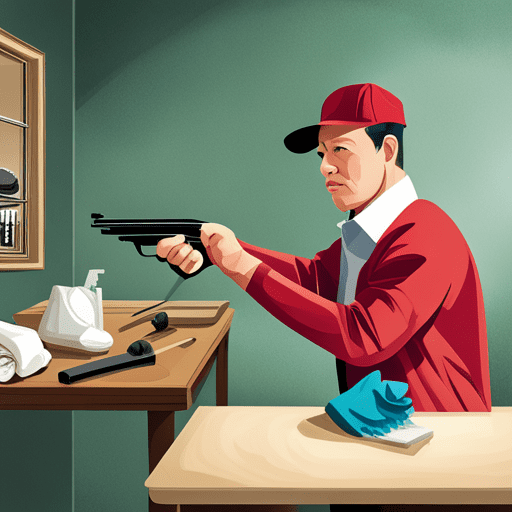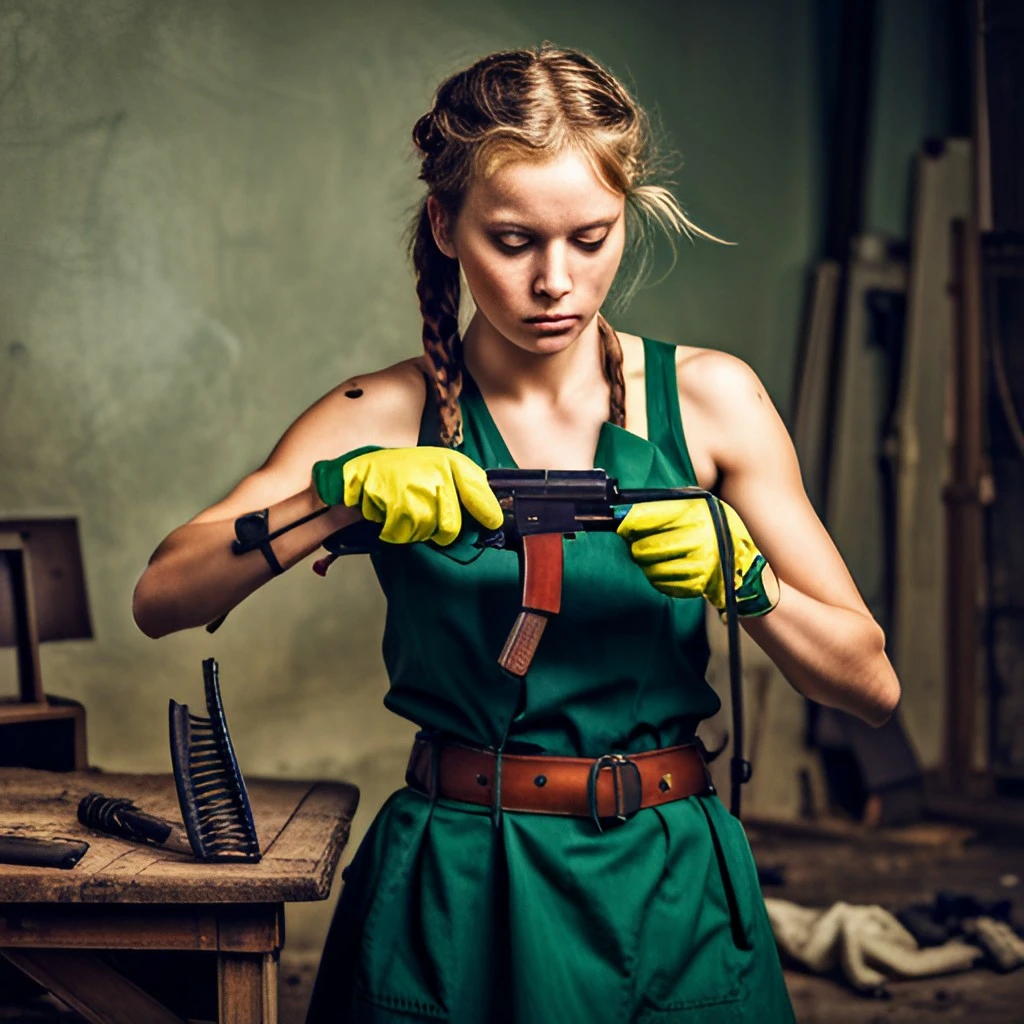Proper cleaning and maintenance of your firearm are critical to ensure its optimal performance, longevity, and safety. Whether you’re a seasoned shooter or a beginner firearm owner, understanding how to effectively clean your firearm is a skill that can’t be overstated. Let’s walk you through the first step in cleaning a firearm and provide a comprehensive guide for the entire process.
Table of Contents
Step 1: Ensure Firearm Safety

Safety should always be your top priority when handling firearms. Before you begin the cleaning process, it’s mandatory to follow these safety precautions:
- Always treat the firearm as if it’s loaded: Even if you know the firearm is unloaded, always handle it as though it’s loaded. This practice helps prevent accidental discharges.
- Ensure the firearm is not loaded before cleaning: Make sure to unload your firearm before starting the cleaning process. Check the chamber and remove any ammunition from the area to prevent accidental loading.
- Point the firearm in a safe direction: Always point the muzzle of your firearm in a safe direction, away from yourself and others, while cleaning.
- Wear protective gear: Wear eye protection and gloves to protect yourself from any potential hazards during the cleaning process.
- Keep your finger off the trigger: Keep your finger off the trigger at all times unless you’re ready to fire the firearm.
- Store ammunition separately: It’s crucial to store your ammunition in a separate location from where you clean your firearm. This helps avoid confusion and potential accidents.
Step 2: Gather Cleaning Tools and Materials

The next step is to gather your cleaning tools and materials. Using quality cleaning supplies is important to ensure effective cleaning and to prevent potential damage to your firearm.
Recommended cleaning supplies typically include:
- Bore brush
- Cleaning rod
- Gun oil or lubricant
- Cleaning solvent
- Cotton swabs
- Microfiber cloths
- Cleaning patches
- Toothbrush or nylon brush
- Screwdriver (if needed for disassembly)
Be sure to check your firearm’s manufacturer recommendations for any specific cleaning tools or materials that may be required.
Step 3: Follow Manufacturer’s Instructions
Every firearm is different. That’s why it’s crucial to read and follow the manufacturer’s cleaning instructions for your specific model. These instructions provide detailed information about the correct disassembly, cleaning, and reassembly procedures.
Step 4: Disassemble the Firearm
In most cases, you’ll need to disassemble your firearm for a thorough cleaning. Remember to follow the manufacturer’s instructions for disassembly to avoid causing damage to the firearm. Keep track of all components and organize them in an orderly fashion to facilitate the reassembly process.
Step 5: Clean the Firearm Components
Now, you’re ready to start cleaning. Each component requires careful attention:
- Barrel: Use a cleaning rod with a bore brush attachment soaked in cleaning solvent. Push the rod through the barrel, starting from the breech end (where the cartridge enters) to the muzzle end (where the bullet exits).
- Slide and Frame: Use a small brush to clean these parts. Apply a firearm-approved cleaner and scrub away any visible dirt or residue.
- Magazine and Firing Mechanism: Clean these parts using a dry brush and cotton swabs. Avoid using cleaning solvents on these components to prevent potential damage.
Step 6: Reassemble the Firearm
After all the components are clean and dry, it’s time to reassemble your firearm. Again, refer to your manufacturer’s instructions to ensure everything goes back to its proper place. Be patient and don’t force parts together; they should fit together smoothly.
Step 7: Perform Function and Safety Checks
After your firearm is reassembled, perform a function check to ensure everything is working properly. Check the safety mechanism, the trigger, and the magazine release. If everything checks out, your firearm is clean and ready for storage or use.
Step 8: Properly Store Your Firearm
Once your firearm is clean, it’s essential to store it correctly to protect it and ensure it remains in optimal condition. Store your firearm in a dry, temperature-controlled environment to prevent rusting and damage. If possible, use a padded gun case and consider using a dehumidifier in humid climates.
Step 9: Regularly Maintain Your Firearm
Regular maintenance is critical, even if the firearm is not frequently used. Over time, dust and moisture can accumulate, leading to potential issues. It’s advisable to perform a full cleaning and inspection every few months, even if the firearm is not in use.
Step 10: Keep Updating Your Knowledge
Firearm technology and cleaning techniques evolve over time. Stay informed about the latest cleaning methods, tools, and safety measures. Also, consider attending workshops or joining firearm forums to continually improve your knowledge and skills.
Frequently Asked Questions
Q1: How often should I clean my firearm?
A1: The frequency with which you should clean your firearm depends on how often you use it. As a rule of thumb, it’s recommended to clean your firearm after each use. However, if the firearm is stored and not used frequently, it should be cleaned every six months to prevent the accumulation of dust and possible rust.
Q2: Can I use household products to clean my firearm?
A2: It’s not recommended to use household products for cleaning your firearm as they may not effectively remove dirt and build-up, and could potentially damage your firearm. Always use cleaning products designed specifically for firearms.
Q3: Why is it necessary to disassemble my firearm for cleaning?
A3: Disassembling your firearm allows for a thorough cleaning of each component, ensuring the removal of all dirt, grime, and residue that could hinder your firearm’s performance. However, always follow the manufacturer’s instructions for disassembly to prevent any damage.
Q4: What safety measures should I take while cleaning my firearm?
A4: Safety measures include treating the firearm as if it’s loaded, ensuring the firearm is not loaded before cleaning, pointing the firearm in a safe direction, wearing protective gear, keeping your finger off the trigger, and storing ammunition separately.
Q5: What if I can’t reassemble my firearm after cleaning?
A5: If you can’t reassemble your firearm after cleaning, it is recommended to consult your firearm’s user manual or seek assistance from a professional gunsmith. Never attempt to force parts together as it can cause damage.
Conclusion
Regular firearm cleaning and maintenance are not just about the firearm’s performance—it’s also about your safety. By following these steps, you’ll help ensure your firearm operates reliably when you need it to.
Also, remember to always store your firearm securely and legally. Always consult your local regulations regarding firearm storage and abide by them to ensure safety and compliance.
In the world of firearms, knowledge is power, and responsibility is paramount. So, keep learning, stay safe, and always respect the power of your firearm. Happy cleaning!






